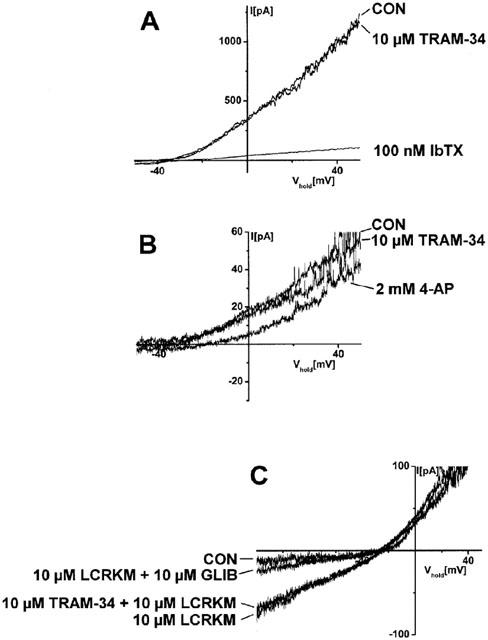Figure 2.

TRAM-34 did not affect the function of BK-, KV-, and KATP-channels in CASMC. (A) Whole-cell recordings of BK-currents in the presence or absence of TRAM-34 (10 μM) and blockade of BK-currents by selective BK-blocker iberiotoxin (IbTX, 100 nM). For KCa-activation CASMC were dialysed with a 140 mM K+ pipette solution containing 3 μM [Ca2+]free. Bathing solution contained 4.5 mM K+. The experiment shown is representative of seven experiments with similar results. (B) Whole-cell recordings of KV-currents in the presence or absence of TRAM-34 (10 μM) and blockade of KV-currents by the KV-blocker 4-aminopyridine (4-AP, 2 mM). CASMC were dialysed with a 140 mM K+-pipette solution containing 0.1 μM [Ca2+]free. The experiment shown is representative of ten experiments with similar results. Bathing solution used for measurements of BK- and KV-currents contained 4.5 mM K+. (C) Levcromakalim (LCRKM, 10 μM)-induced whole-cell currents through KATP-channels in CASMC in absence and presence of TRAM-34 (10 μM) and blockade of KATP-currents by the KATP-blocker glibenclamide (GLIB, 10 μM). CASMC were dialysed with a 140 mM K+-pipette solution containing 0.1 μM [Ca2+]free and 5.3 μM [ATP]free. Bathing solution contained 50 mM K+. Note that under these conditions and at holding potentials more negative than −26 mV, KATP currents were inwardly directed. The experiment shown is representative of eight experiments with similar results.
